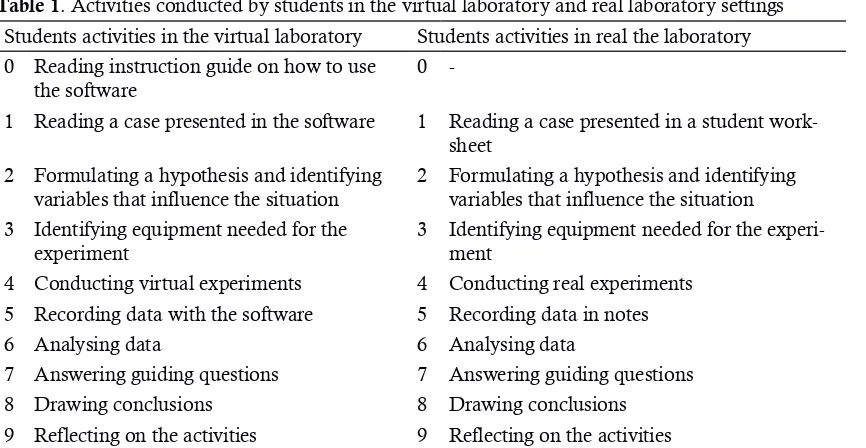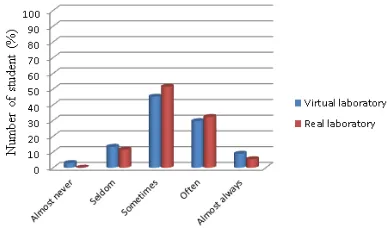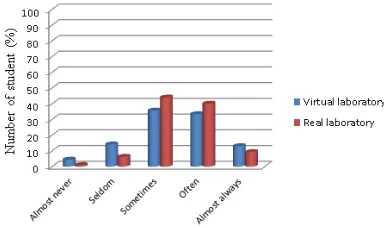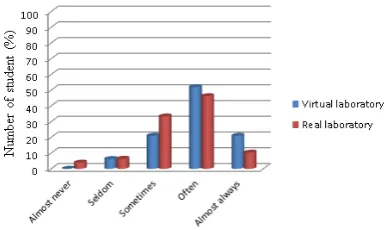Biosaintifika
Journal of Biology & Biology Educationhttp://journal.unnes.ac.id/nju/index.php/biosaintifika
Constructivist Learning Environment During Virtual and Real
Laboratory Activities
Ari Widodo, Resik Ajeng Maria, Any Fitriani
DOI: 10.15294/biosaintifika.v9i1.7959
Faculty of Mathematics Education and Natural Sciences, Universitas Pendidikan Indonesia, Indonesia
Abstract
Laboratory activities and constructivism are two notions that have been playing significant roles in science education. Despite common beliefs about the importance of laboratory ac-tivities, reviews reported inconsistent results about the effectiveness of laboratory activities. Since laboratory activities can be expensive and take more time, there is an effort to introduce virtual laboratory activities. This study aims at exploring the learning environment created by a virtual laboratory and a real laboratory. A quasi experimental study was conducted at two grade ten classes at a state high school in Bandung, Indonesia. Data were collected using a questionnaire called Constructivist Learning Environment Survey (CLES) before and after the laboratory activities. The results show that both types of laboratories can create constructivist learning environments. Each type of laboratory activity, however, may be stronger in improv-ing certain aspects compared to the other. While a virtual laboratory is stronger in improvimprov-ing critical voice and personal relevance, real laboratory activities promote aspects of personal relevance, uncertainty and student negotiation. This study suggests that instead of setting one type of laboratory against the other, lessons and follow up studies should focus on how to combine both types of laboratories to support better learning.
How to Cite
Widodo, A., Maria, R. A. & Fitriani, A. (2017). Constructivist Learning Environ-ment During Virtual and Real Laboratory Activities. Biosaintifika: Journal of Biology & Biology Education, 9(1), 11-18.
© 2017 Universitas Negeri Semarang History Article
Received 21 November 2016 Approved 30 January 2017 Published 1 April 2017
Keywords constructivist learning environment; real labora-tory; virtual laboratory
Correspondence Author:
Jl. Dr. Setiabudhi No. 229 Bandung 40154 E-mail: [email protected]
Taylor & Fraser, 1991; Taylor, Fraser, & Fisher, 1997). CLES is widely used in many countries, including the US (Partin & Haney, 2012), Hong Kong (Kwan & Wong, 2014), Iran (Ebrahimi, 2015), Turkey (Anagun & Anilan, 2013), South Africa (Luckay & Laugksch, 2015), and Indone-sia (Widodo, et al., 2010). These studies report that CLES is reliable and can be used to measure a constructivist learning environment based on five aspects: personal relevance, uncertainty criti-cal voice, shared control, and student negotiation. Studies on constructivist learning envi-ronment have reported different results. Some studies found that lessons met the criteria of con-structivist learning environments (Zeidan, 2015), while others report the opposite results (Ozkal, et al., 2009). Studies conducted in Indonesia have also revealed inconsistencies. While a study con-ducted by Yulianti (2006) reported that lessons did not meet indicators of a constructivist learn-ing environment, others reported that the use of e-books promote lessons to be more constructiv-ist (Fitriana, 2010; Nurbaety, 2010).
The main aims of this research are: First, to analyse the learning environment during vir-tual laboratory and real laboratory activities, and secondly, to identify the criteria of a constructiv-ist learning environment promoted by each type of laboratory activity.
METHODS
The study was conducted at a state high school in Bandung that has nine grade 10 classes. For the purpose of this study two classes were chosen using the cluster sampling technique. One class was assigned as the treatment class while the other class was assigned as the control class. The number of the students in the treatment class was 27 while the number of students in the con-trol class was 26.
The study employed a pre and post-test design of quasi-experimental research. The treat-ment class worked with a virtual laboratory while the control class worked in a real laboratory. Data was collected using the CLES administered be-fore and after the laboratory activities. Detailed activities of both classes are presented in Table 1. A descriptive data analysis was conducted on the student responses to the questionnaire. Average scores of student responses were calcu-lated based on individual student scores. In addi-tion, a more detailed analysis was also conducted to identify the criteria of the constructivist lear-ning environment (personal relevance, uncertain-ty critical voice, shared control, and student
nego-INTRODUCTION
In a typical science textbook, such as Camp-bell Biology (Reece et al., 2011) “Plant growth and development” covers plant tissues, primary and secondary growth, morphogenesis, and cell differentiation. In most Indonesian school books, however, the content is limited to germination and factors that influence plant growth (Kistinah & Lestari, 2009; Subardi, Nuryani, & Pramono, 2008). In addition, the term “growth” is limited to the growth of a whole plant and does not cover “growth” in terms of tissues culture, such as the growth of plantlet or callus (Hasanah, Suwarsi, & Sumadi, 2014; Nurchayati, Santosa, Nugroho, & Indrianto, 2016). Since the content consists of concrete and abstract concepts, real laboratory activities are insufficient to deliver the full con-tent.
Although traditionally laboratory activities have been regarded as important for science les-sons, laboratory activities are not well-represent-ed in the curriculums (Ferreira & Morais, 2014). Research on the effectiveness of laboratory ac-tivities also reports variable results (Abrahams & Millar, 2008; Harlen, 1999). A study conducted by Abrahams and Millar (2008) suggested that laboratory activities help students to memorise practical aspects of the experiments related to natural phenomena. A review of the roles of lab-oratory activities for the Indonesian setting con-ducted three decades ago (Thair & Teagust, 1977) reported that laboratory activities promoted stu-dents’ achievement in cognitive, problem solving as process skills. More recent review unfortunate-ly are not available.
Compared to other teaching strategies, laboratory activities are relatively high cost. Computer technology offers a solution for con-ducting laboratory activities at a lower cost in the form of virtual laboratory (Flowers, 2011). In virtual laboratory settings students conduct laboratory activities, but the activities are un-dertaken through computer software. According to Scheckler (2003), virtual laboratories offer a number of advantages, like allowing students to repeat the activities, omitting the risk of danger-ous experiments, and reducing the time and costs.
tiation) promoted by virtual laboratory activities and real laboratory activities. Average scores for each criterion are calculated based on students’ responses to five statements that represent each criterion.
RESULTS AND DISCUSSION
In general, students in this study gave a pos-itive impression about the laboratory activities. A comparison between the two types of laborato-ries using CLES shows that real laboratory learn-ing environment is slightly more constructivist than virtual laboratory (Figure 1). This result is quite similar to a previous study reported by Fra-ser & Lee (2009) that students preferred to have real laboratory activities. Opportunities to have hands on experience and to do things of their in-terest are factors that contribute to students’ posi-tive views on laboratory activities (Toplis, 2012).
Figure 1. Constructivist learning environments in both types of laboratory settings before and after the lessons
Analysis of the scores before and after the
laboratory activities, however, show that the vir-tual laboratory promotes a constructivist learning environment slightly better than the real labora-tory (Figure 1). While virtual laboralabora-tory activities showed improvement, real laboratory activities did not.
The CLES scores reported in this study are higher than a previous study conducted with junior high school students (Yulianti, 2006) as well as studies conducted in Turkey (Ozkal et al., 2009) and Vietnam (Thao-Do, et al., 2016). The scores are, however, lower than found in Palestine (Zeidan, 2015). In general, studies on constructivist learning environments suggest that students’ active involvement in hands on ac-tivities may lead to better constructivist learning environments. In addition, in a cultural context where students have a high respect to the teach-ers, they also tend to perceive their learning envi-ronment as more constructivist (Aldridge et al., 2000). These results suggest that constructivist learning environments are shaped by physical factors, such as the use of hands on material as well as psychological factors, such as respect for the teacher.
A more detailed analysis for each criteri-on of the learning envircriteri-onment shows that real laboratory activities score higher on all criteria, except for “Student Negotiation” (Figure 2). The aspect of student negotiation scored higher in the virtual laboratory since that environment allows students to make decisions on their own and to be independent learners (Donnelly, O’Reilly, & Mc-Garr, 2013; Scheckler, 2003). Unlike their fellow students in the real laboratory class who have to follow the instruction in the worksheet, students
Table 1. Activities conducted by students in the virtual laboratory and real laboratory settings
Students activities in the virtual laboratory Students activities in real the laboratory
0 Reading instruction guide on how to use
the software
0
-1 Reading a case presented in the software 1 Reading a case presented in a student
work-sheet
2 Formulating a hypothesis and identifying
variables that influence the situation
2 Formulating a hypothesis and identifying
variables that influence the situation
3 Identifying equipment needed for the
experiment
3 Identifying equipment needed for the
experi-ment
4 Conducting virtual experiments 4 Conducting real experiments
5 Recording data with the software 5 Recording data in notes
6 Analysing data 6 Analysing data
7 Answering guiding questions 7 Answering guiding questions
8 Drawing conclusions 8 Drawing conclusions
in the virtual laboratory have the opportunities to explore and to make “trial and error” guesses without worrying about the consequences.
Figure 2. Comparison of each criterion of the learning environment in the virtual laboratory and the real laboratory settings
The study reported here also found that ‘Shared Control’ is the lowest scored CLES cri-terion. This was also observed by Thao-Do et al. (2016) in their study in Vietnam and Aldridge et al. (2000) who conducted a study in Taiwan. Traditional views on the roles of teachers and students, where teachers are considered more knowledgeable and students are expected to fol-low them, may contribute to these results. In many cases teachers give too much directions to the students to do the laboratory activities and give few opportunities to the students to explore and try out their ideas. As a result, students are given less control over their own learning. Some of the teachers’ reasons for such tight control dur-ing laboratory activities is to avoid experimental failure. It is one of the reasons why extended time is usually spent on pre-laboratory activities (Widodo & Ramdhaningsih, 2006).
The pattern of distribution of students’ re-sponses shows that students in both classes pre-dominantly answered “Sometime” and “Often” (Figure 3). This suggests that students at both classes gave similar responses.
Figure 3. Distribution of students’ responses in both classes
Personal relevance
As presented in Figure 4, there is an ob-servable difference in the pattern of students’ responses between virtual and real laboratory classes. While the students in the real laboratory setting frequently choose “often”, their cohorts using the virtual laboratory tended to choose “sometimes”.
Figure 4. Pattern of students’ responses on CLES criterion of “Personal relevance”
Different responses on this criteria indi-cate that real laboratory activities provide more opportunities to the students to relate the labora-tory activities to their daily life experiences. As reported in the previous study (Widodo et al., 2010), doing real experiments using resources available in daily life helps students to generate more meaningful learning.
Uncertainty
Figure 5 shows that students’ responses on ‘Uncertainty’ are similar regardless of the labo-ratory settings they experienced. Students from both groups most frequently choose “sometimes” on questions of the extent to which the labora-tory activities promoted uncertainty.
Figure 5. Pattern of students’ responses on the CLES criterion of “Uncertainty”
results of their experiments may contribute to science. Although the laboratory activities in this study were designed to facilitate students to do inquiry, the implementation was very much content-oriented and gave little opportunity for students to experience “uncertainty”. In line with the notion that science is tentative, teachers should present lab activities in ways that value students’ ideas and findings. It is worth consider-ing Abrahams & Millar’s (2008) suggestions that laboratory activities should not only aim at deve-loping students’ substantive scientific knowledge, but also develop students’ understanding of the processes scientific enquiry so that laboratory ac-tivities can develop students scientific knowledge, skills and attitudes.
As documented in previous studies (Hofs-tein & Lunetta, 2004), one of the weaknesses of school laboratory activities is that most of the ac-tivities are simply verification and cook-book ex-ercises. Lab activities designed to verify existing theories and evidence put students in an “incom-petence” position when they are unable to prove the theory with their own results. As Abrahams & Millar (2008) said, cook-book recipe labora-tory activities are likely to be used in schools. To improve the benefit of such laboratory activities, teachers should give a greater proportion of the time to help students make use of the ideas they discover in the laboratory activities rather than just focus on the successful completion of the ac-tivities.
Critical Voice
As shown in Figure 6, there is a different pattern of student responses on ‘Critical Voice’ criterion. While students working in the real lab-oratory tended to say “often” and “sometimes’, students in the virtual laboratory setting gave somewhat more diffuse responses. This suggests that the virtual laboratory setting is perceived dif-ferently by different students.
Figure 6. Pattern of students’ responses on the CLES criterion of “Critical Voice”
Shared control
Figure 7 shows that there is variability in students’ responses on the ‘Shared Control’ cri-terion. In the virtual laboratory setting students’ responses tended toward “almost never” and “seldom” while students in the real laboratory setting responses with “sometimes” and “often”. Although students in both groups used similar worksheets, students in the real laboratory per-ceived that they were given opportunities to con-trol their own learning more than students using a virtual laboratory. As reported by Toplis (2012), students saw real laboratory activities as learning experiences that promote participation, autono-my and interest. Therefore it is reasonable that students in the real laboratory setting perceived that the teacher shared more control.
Figure 7. Pattern of students’ responses on CLES criterion of “Shared Control”
The different patterns of student responses indicate that virtual laboratory activities and real laboratory activities create different learning en-vironments in terms of giving opportunities for students to share the control of the lessons with their teacher. Articulating learning goals, design and management of learning activities and as-sessment criteria are important aspects of lessons that may be shared.
Student Negotiation
In contrast to the criterion of ‘Shared Con-trol’, students in the virtual laboratory settings gave more positive responses on the criterion of ‘Student Negotiation’ (Figure 8).
suggest that the best alternative is to start a lesson with real laboratory activities and follow it with virtual laboratory activities. In such a sequence, students have opportunities to explore and inter-act with the real situation before exploring more possibilities virtually.
The recognition of the importance of labo-ratory activities in the Indonesian curriculum is clearly reflected in the teaching approach rec-ommended by the government, i.e. the scientific approach (Kementerian Pendidikan dan Kebu-dayaan Republik Indonesia, 2013). The imple-mentation of the scientific approach in teach-ing requires a teacher to provide a certain level of laboratory exposure to the students. Previous studies however, have reported that real labora-tory activities are rarely conducted due to reasons such as unavailable of equipment, limited school budget, and prolonged time needed in the class (Yenita, et al., 2013). Virtual laboratory activities may offer a good alternative for laboratory activi-ties that demand observation at an analytical lev-el such as measuring the absorption of metal ions by a certain plant callus (Nurchayati et al., 2016) or exploring different composition of growth me-dia (Hasanah et al., 2014). Virtual laboratory ac-tivities are worth considering in schools either as an alternative to real laboratory activities or as a complement to the real laboratory activities.
The result of this study shows that both types of laboratory activities can create a con-structivist learning environment and therefore biology teachers may choose either type of labo-ratory activity in the lessons. However, since each type of laboratory activity has particular strengths and weaknesses, in planning the activities biology teachers should bear in mind strategies to reduce the weaknesses and improve the strengths of the chosen laboratory activities. In the context of the implementation of the new curriculum (Kuriku-lum 3013) that requires teachers to implement scientific approach in their teaching, teachers can perform demonstration to raise students’ ques-tions followed by virtual laboratory or vice versa. For the future research, this study suggests that researchers should focus on finding the best com-bination of virtual and real laboratory activities and how they may facilitate students’ learning progression and conceptual change.
CONCLUSION
Both virtual laboratory and real laboratory activities can improve the learning environment to become more constructivist. Each type of la-boratory, however, contribute differently to each and challenging each other’s ideas. This result fits
a finding reported by Donnelly, et al. (2013) that virtual laboratory activities give more emphasis on the “minds on” part of the laboratory ac-tivities. In the virtual laboratory setting students have the opportunity to design and test their ideas in very quick ways.
Figure 8. Pattern of students’ responses on CLES criterion of “Student Negotiation”
In general, this study finds that virtual laboratory and real laboratory activities can cre-ate constructivist learning environments. It sug-gests that both types of laboratories can provide a learning environment that supports students in constructing new knowledge. Since the national curriculum (Kurikulum 2013) is also based on constructivism (Kementerian Pendidikan dan Kebudayaan, 2014) teachers may use either vir-tual laboratory or real laboratory activities, or a combination of both. The results of this study also support previous studies on constructiv-ist learning environments as contributing to an improvement in student learning. Two separate studies conducted by Alt (2015) and Partin & Haney (2012) show that constructivist learning environments contribute to the improvement of students’ academic self-efficacy. Other studies have also reported improvement in students’ criti-cal thinking skills (Kwan & Wong, 2014) and stu-dents’ conceptual understanding (Widodo et al., 2010).
aspect of the constructivist learning environ-ments. While a virtual laboratory is powerful in improving critical voice and personal relevance, real laboratory activities promote aspects of per-sonal relevance, uncertainty and student negotia-tion. The current study suggests that each type of laboratory activity has weaknesses and strengths and for this reason, lessons should combine both virtual laboratory and real laboratory activities in order to maximise the opportunity to create a constructivist learning environments.
REFERENCES
Abrahams, I., & Millar, R. (2008). Does practical work really work? A study on the effectiveness of practical work as a teaching and learning meth-od in school science. International Journal of Sci-ence Education, 30(14), 1945-1969.
Aldridge, J. M., Fraser, B. J., Taylor, P. C., & Chen, C. (2000). Constructivist learning environment in a cross-national study in Taiwan and Australia.
International Journal of Science Education, 22(1), 37-55.
Alt, D. (2015). Assessing the contribution of a con-structivist learning environment to academic self-efficacy in higher education. Learning Envi-ronment Research, 18(1), 47-67.
Anagun, S. S., & Anilan, H. (2013). Development and validation of a modified Turkish version of the Teacher Constructivist Learning Environ-ment Survey (TCLES). Learning Environment Research, 16(2), 169-182.
Donnelly, D., O’Reilly, J., & McGarr, O. (2013). En-hancing the student experiment experience: Visible scientific inquiry through virtual chem-istry laboratory. Research in Science Education, 43(4), 1571-1592.
Ebrahimi, N. A. (2015). Validation and application of the Constructivist Learning Environment Survey in English language teacher education classrooms in Iran. Learning Environment Re-search, 18(1), 69-93.
Ferreira, S., & Morais, A. M. (2014). Conceptual de-mand of practical work in science curricula: A methodological approach. Research in Science Education, 44(1), 53-80.
Fitriana, A. (2010). Pengaruh E-book Bermultimedia ter-hadap Penguasaan Konsep dan Lingkungan Pem-belajaran Siswa SMP pada Subkonsep Ciri-Ciri Makhluk Hidup. Universitas Pendidikan Indo-nesia, Bandung.
Flowers, L. O. (2011). Investigating the effectiveness of virtual laboratories in undergraduate biology course. The Journal of Human Resource and Adult Learning, 7(2), 110-116.
Fraser, B. J., & Lee, S. S. U. (2009). Science laboratory classroom environment in Korea high school.
Learning Environment Research, 12(1), 67-84.
Harlen, W. (1999). Effective Teaching of Science: A Review of Research. Edinburgh: The Scottish Council for Research in Education.
Hasanah, U., Suwarsi, E. R., & Sumadi. (2014). Pe-manfaatan pupuk daun, air kelapa dan bubur pisang sebagai komponen media pertumbuhan plantlet anggrek Dendrobiumkelemense. Biosain-tifka, 6(2), 161-168.
Hofstein, S., & Lunetta, V. N. (2004). The laboratory in science education: Foundation for the twenty first century. Science Education, 88(1), 28-54. Kementerian Pendidikan dan Kebudayaan. (2014).
Konstruktivisme dalam Kurikulum 2013. In: http://www.kemdikbud.go.id/main/ blog/2014/03/konstruktivisme-dalam-kuriku-lum-2013-2311-2311-2311.
Kementerian Pendidikan dan Kebudayaan Republik Indonesia. (2013). Peraturan Menteri Pendidikan dan Kebudayaan Republik Indonesia nomer 65 ta-hun 2013 tentang Standar Proses. Jakarta. Kistinah, I., & Lestari, E. S. (2009). Biologi 3: makhluk
Hidup dan Lingkungannya untuk SMA/MA. Ja-karta: Pusat Perbukuan, Departemen Pendidi-kan Nasional.
Kwan, Y. W., & Wong, A. F. L. (2014). The construc-tivist classroom learning environment and its associations with the critical thinking ability of secondary school students in liberal studies.
Learning Environment Research, 17(2), 191-207. Luckay, M. B., & Laugksch, R. C. (2015). The
develop-ment and validation of an instrudevelop-ment to moni-tor the implementation of social constructivist learning environments in grade 9 science class-rooms in South Africa. Research in Science Edu-cation, 45(1), 1-22.
Nurbaety, A. (2010). Pengaruh Buku Elektronik Interak-tif terhadap Penguasaan Konsep dan Lingkungan Pembelajaran Siswa SMA pada Subkonsep Sistem Indera. Universitas Pendidikan Indonesia, Bandung.
Nurchayati, Y., Santosa, Nugroho, L. H., & Indrianto, A. (2016). Growth pattern and copper accu-mulation in callus of Datura metel. Biosaintifika, 8(2), 135-140.
Olympiou, G., & Zacharia, Z. C. (2011). Blending physical and virtual manipulatives: An effort to improve students conceptual understanding through science laboratory experimentation.
Science Education, 96(1), 21-47.
Ozkal, K., Tekkaya, C., & Cakiroglu, J. (2009). Inves-tigating 8th grade students’ perceptions of con-structivist science learning environment. Educa-tion and Science, 34(153), 38-46.
Reece, J. B., Urry, L. A., Cain, M. L., wasserman, S. A., Monorsky, P. V., & Jackson, R. B. (2011).
Campbell Biology (9th ed.). San Fransisco: Pear-son.
Scheckler, R. K. (2003). Virtual labs: A substitute for traditional labs? International Journal of Develop-mental Biology, 47(2/3), 231-236.
Subardi, Nuryani, & Pramono, S. (2008). Biologi 3: Un-tuk kelas XII SMA dan MA. Jakarta: Pusat Per-bukuan, Departemen Pendidikan Nasional. Taghavi, S. E., & Colen, C. (2009). Computer
simula-tion laboratory instrucsimula-tion vs. tradisimula-tional labo-ratory instruction in digital electronics. Journal of Information Technology Impact, 9(1), 25-33. Taylor, P. C., & Fraser, B. J. (1991). CLES: An
Instru-ment for Assessing Constructivist Learning En-vironment. In. Perth: Science and Mathematics Education Center, Curtin University of Tech-nology.
Taylor, P. C., Fraser, B. J., & Fisher, D. (1997). Moni-toring constructivist learning environment. In-ternational Journal of Educational Research, 27(4), 293-302.
Thair, M., & Teagust, D. F. (1977). A review of teacher development reforms in Indonesian secondary science: The effectiveness of practical work in biology. Research in Science Education, 27(4), 581-597.
Thao-Do, T. P., Bcy-Ly, D. T., & Yuenyong, C. (2016).
Lerning environment in Vietnamese phys-ics teacher education programme through the lens of constructivism: A case study of a state university in Mekong Delta Region Vietnam.
International Journal of Science and Mathematics Education, 14(Suplemen 1), 55-79.
Toplis, R. (2012). Students’ view about secondary sci-ence lessons: The roles of practical work. Re-search in Science Education, 42(3), 531-549. Widodo, A., Nugraha, I., Trisnawati, R., Nurbaety,
H., & Biana, B. (2010). The use of interactive e-book to promote constructivist learning environment in biology lessons. Paper presented at the The fourth International Seminar on Science Edu-cation, Bandung.
Widodo, A., & Ramdhaningsih, V. (2006). Analisis ke-giatan praktikum biologi dengan menggunakan video. Metalogika, 9(2), 146-158.
Yenita, Mugisukwati, & Zulirfan. (2013). Hambatan pelaksanaan praktikum IPA Fisika yang diha-dapi guru SMP Negeri di Kota Pekanbaru. Jur-nal Pendidikan, 3(01).
Yulianti, F. (2006). Iklim Lingkungan Pembelajaran Biolo-gi di SMP X Berdasarkan Prinsip Konstruktivisme.
Universitas Pendidikan Indonesia, Bandung. Zeidan, A. (2015). Constructivist learning



